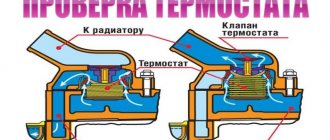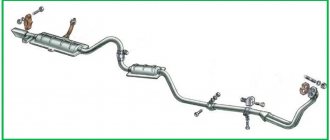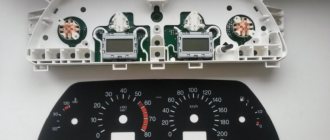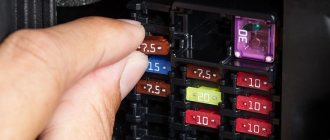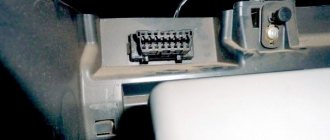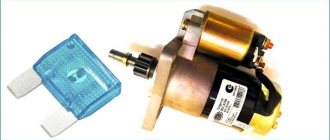Most spontaneous car fires are associated with short circuits in electrical wiring. Electricians call this problem “shorty.” In their opinion, this is a really serious problem that can lead to unpredictable consequences.
When electrical wiring malfunctions occur, many motorists begin to panic and look for a car electrician. In fact, you can diagnose an electrical circuit yourself using a multifunction tester.
How to find a short circuit in a car wiring
What is a short circuit? A short circuit is a connection between two points (wires) having different potentials (plus and minus), which should not occur during normal operation of the device. We are talking about a car (motorcycle, ATV, snowmobile), so we will consider ways to find a short circuit for a car. The article is intended for novice auto electricians and advanced car owners; if you don’t know what a multimeter is, it’s better to contact a service center, it will be faster and cheaper, in the end everyone should mind their own business. The article contains several fictitious examples of searching for short circuits and links to real examples of finding and eliminating short circuits in cars from my practice.
As you know, all electrical circuits in a car (with the exception of the starter power circuit) are protected by fuses. A short circuit will always cause the fuse protecting this circuit to burn out, and there is nothing wrong with the short circuit itself. The danger arises when people, without understanding the cause of the fuse blowing, replace the fuse with a higher rating, or install fuses of unknown manufacture at a cost of one hundred rubles per bucket. Such fuses are made of unknown materials and may not burn out at all.
To find a short circuit, we use an electrical circuit, a multimeter, and sometimes we use a light bulb as a tool. Finding electrical diagrams is not a big problem now; in the simplest cases you can do without a diagram, but I advise an electrician to always look at diagrams to improve their skills.
For example, a Nissan Qashqai came to us with the heated mirrors not working. First of all, we check the fuse for the heated mirrors in the interior fuse box, it is working, we check whether there is power to it when the rear window heating is turned on, there is no power. Let's look at the diagram.
The mirror fuse is located in the interior fuse box. And in the IPDM block there is a relay for turning on the heated rear window and mirrors and two 15 amp fuses connected in parallel. Nissan always puts two fuses in parallel. Check the fuses for blown ones. Our task is to find and eliminate the short circuit with minimal time and minimal disassembly of the car. The weak point in this case is the corrugation, the transition from the body to the trunk door, open and look, it takes a couple of minutes, we look - the wires are intact. Next, you need to, with as little disassembly as possible of the interior, determine the section of the wiring where there is a short circuit.
We have excellent access to the mirror fuse, so we’ll start measuring from there. We take out the fuse so as not to measure the mirror circuit and use a multimeter in ohmmeter mode, or continuity measurements, measure the resistance
Let's assume a resistance of 0.5 ohms - there is a short circuit. Next, you need to decide in which part of the wiring to look for this short circuit; using the connector layout diagram, we will find where the connection E101 - B11 is located.
The connector is located quite conveniently; you only need to remove the sill trim and kick panel. We disconnect the connector and measure the resistance on both sides of the connector.
Let's say there is a short circuit in that part of the wiring that goes to the rear of the car. We already checked the wires in the corrugation at the very beginning, there are no more connectors, so all that remains is to disassemble and look. Damage to the wiring is almost always visible; we remove the rear sill trim and see the damaged wires and the consequences of body repairs.
Hurray, we made a lot of money without destroying half the car. This situation is fictitious, all coincidences are random. Yes, and this cannot happen, do bodybuilders ever make mistakes, no, this simply does not happen).
I recommend conducting such training regularly, open the diagram of any car, come up with a fault and ways to diagnose and eliminate it, gain experience in reading electrical diagrams and troubleshooting. The time spent will definitely pay off when repairing real cars.
Here the ignition switch fuse on the MMC Pajero burned out https://aelectrik.ru/stati/ne-zavoditsya-micubisi-padzhero-sport/ the car accordingly did not start
Another way
Also, when searching for a short circuit, auto electricians often use a regular incandescent lamp. In this case, instead of a blown fuse, we connect a lamp to the circuit, I usually use H4, there are a lot of them lying around with a burnt-out low beam filament.
For example, we have an MMC Pajero 4 with non-working reverse lights and a blown fuse. You can look for a fault as in the previous case, but it will be easier and faster to connect a lamp instead of a fuse, turn on the ignition, reverse gear, and this lamp flashes at full intensity, but there are no reverse lights. This means that there is a short circuit in the reverse lamp circuit. Our lamp limits the current in this circuit; it will not be more than what the lamp consumes and at the same time serves as an indicator that a short circuit is present.
At the same time, we immediately note that the lamp lights up only after we engage reverse gear, that is, there is definitely no short circuit in the area from the fuse to the gear selector (and by the way, there are two connectors and branches there, quite a few have already been cut off). Next we go and disconnect the connectors from the rear lights. The lamp continues to light, that is, the short circuit is not in the lamps. Next, working from simple to complex, we climb under the car and find the gear selector connector S-05 on the box (let’s say we have an automatic).
And we begin to actively move the wiring on the box, and at the same time we see that our lamp has started to blink, that is, the short circuit disappears, then everything is simple, we find the place of damage and repair it. It will look something like this
Of course, you will say, it’s easy to look for such short circuits, just try to find a short circuit that appears once a week, or even less often. It happens, in this case, we check the most likely places and if we find nothing, we separate the different circuits hanging on one fuse with our own fuses, as in this Lexus, by the way, that Lexus is still driving to this day, the short circuit no longer appears.
Successful repairs and no harmful clients to all. If you have interesting cases from practice, write in the comments.
Source
Cable testers
This class of devices allows you to check both the integrity of the cable and the correctness of its connection, which is very important for Internet provider networks. These can be simple devices that check crossover or complex devices on a PIC controller that have an ADC and a built-in multiplexer.
Multipurpose cable tester Pro'sKit MT-7051N on a microcontroller
Naturally, the cost of such devices does not encourage their household use.
Recommendations
First, decide on the type of short circuit:
For example, let's take a simple car. You noticed that the left front parking lamp began to spontaneously go out and light up. Find the wiring diagram in the instructions and familiarize yourself with it. Now look at what wires are connected to your lamp. Start disassembling the problematic circuit, disconnect the lamp itself and check the power. If the problem is not power, then look for the adjacent connector in the circuit; in your car it is located near the left fender of the car. Disconnect this connector, if the power to the light bulb disappears, then connect the connector and after the lamp lights up, it will become clear to you that a short circuit of two phases occurs between the next connector and the lamp.
Now take care of the connector on the left wing, open the circuit and remove the winding from the wiring, take a close look at the wire leading from the connector to the lamp, if you notice a burnt spot on it after a short circuit, start replacing this section of the wiring with a new one, you should have a soldering iron and just solder the required section and insulate it, protecting it from condensation, check the operation of the car.
A self-powered test lamp helps to detect a short circuit. You just need to disconnect the wiring from both ends of the circuit and also inspect the wires to visually determine the place where the burnt wire is. This lamp can detect a ground fault if you disconnect the battery.
Short circuit in the car
To answer the question of how to find a short circuit in a car, first check all the fuses and relays - as a rule, if there is a short circuit, one of them should fail. After finding such a fuse or relay, find out from the description (on the cover of the fuse box) which unit it belongs to. Next, start examining this unit - visually inspect all the wires running from it to the fuse box.
If external signs of a short circuit are not found in the car, then set the multimeter to resistance measurement mode, and then disconnect the “plus” of the unit being tested from the fuse box and from the device powered by it. Then connect one contact of the multimeter to the positive wire, the second contact to ground. If there is no short circuit, then the resistance on the multimeter will be equal to one. Otherwise, the “plus” somewhere touches the “minus”.
Insulation check
To test insulation with a megohmmeter or multimeter, the principle of continuity is the same as when searching for an electrical connection between the cable cores.
The testing algorithm is as follows:
- set the maximum range on the device – 2000 kOhm;
- connect the probes to the wires and see what the device display shows. Considering that the wires have a certain capacitance until it is charged, the readings may vary. After a few seconds, the device display can display the following values:
- one, this indicates that the insulation between the wires is normal;
- zero – there is a short circuit between the cores;
- some average readings, this can be caused either by a “leak” in the insulation or by electromagnetic interference. To determine the cause, switch the device to the maximum range of 200 kOhm. If the insulation is faulty, the display will display stable readings; if they change, then we can confidently talk about electromagnetic interference.
Attention! Before checking the insulation of the electrical wiring, it must be de-energized. The second important point is that when taking measurements, do not touch the probes with your hands, this can introduce errors.
Video: Wire continuity check - integrity check.
The principle of operation of the electrical circuit of a car
There are many ways to transmit electricity through a car's electrical system. A short circuit can interrupt the necessary flow of electricity. We can conditionally divide the electrical system of a car into circuits of sensors and drives (actuators). The first group includes oxygen sensors, light sensors, speed sensors, etc. Drives include motors, lighting devices and similar consumers.
A typical sensor circuit, such as engine coolant temperature, is the wiring between the electronic engine control unit (ECU) and the coolant temperature sensor (ECT). The ECU can be installed behind the glove box, and the DTOZH can be installed on the engine. The ECU sends a 5V reference voltage to the DTOZH, the resistance of which varies depending on the coolant temperature. If the DTS is cold, it has a higher resistance, so less voltage is returned to the ECU. As the engine heats up, the sensor's resistance drops proportionally, sending higher voltage back to the ECU.
A typical consumer circuit, such as a headlight, consists of wiring from the battery, fuse, relay, switch, bulbs, and wiring back to the battery. The headlight switch always receives power, but it does not direct it to the headlight until the driver turns the switch inside the car.
Any of these circuits operate correctly as long as the wiring is not damaged. There are many ways to interrupt any circuit. Damage from rodents, physical wear and tear of wires, unprofessional installation, moisture ingress and mechanical damage - all this can lead to a break in the car's electrical circuit. A carelessly screwed screw through a wiring harness is a great way to cause a short in your vehicle's wiring to ground, to power, or both.
Finding broken wiring in a car
In order to check a car for current leakage with a multimeter, you will need to perform the same steps. Measuring resistance is an indicator of the presence or absence of contact. In the absence of contact, the resistance tends to infinity (or the number “1” on the device). If there is contact, the resistance should ideally tend to zero (the lower the better). So, to check for a break in the wiring, you need to connect a multimeter to two contacts suspected of a break and measure the resistance; we repeat - a unit on the multimeter screen will indicate a break.
Thanks for subscribing!
To avoid a repeat break, do not twist the wires with your hands. Use only a soldering iron and special heat shrink. If there is a break in the terminal, be sure to clean it before repairing.
Crankshaft sensor
An important element - without it, the car will not start at all, or you will not be able to drive it. If visually it seems to be working, take a multimeter. Connect the device to the sensor and measure the resistance. The norm is usually from 550 to 750 ohms. But be sure to check if these numbers are accurate for the car you're looking at.
Determines whether oxygen remains in the exhaust gases. Before taking measurements, also inspect it - it may be damaged and a multimeter will not be needed at all. Then the element just needs to be replaced.
If everything is in order, measure the voltage and resistance as with the ABS sensor. The algorithm is the same. Start the car and watch the device. After start-up, the numbers 0.1-02 volts will appear on the screen. When the car warms up, the device will show up to 0.9 volts. If you didn’t notice that the indicator has changed, the sensor is most likely faulty.
If the voltage test is successful, find out the resistance readings. The norm ranges from 10 to 40 ohms.
Useful tips Connection diagrams Principles of operation of devices Main concepts Meters from Energomer Precautions Incandescent lamps Video instructions for the master Testing with a multimeter
Features of automotive wiring
Indeed, all these wiring harnesses that encircle the car from top to bottom perform the only task - to ensure the uninterrupted transmission of electrical impulses between the components of a particular system. And if one of the wires has poor contact, or even worse, the terminal is burnt out or oxidized, then the operation of the circuit will be disrupted or even fail.
Replacement is simple; it’s more difficult to find the location of a break or short circuit with your own hands, especially if you don’t know how to do it.
In this article we will try to answer many questions, including:
Troubleshooting wiring requires basic knowledge and precise tools.
What's under the hood
In the engine compartment there are many wires that perform a wide variety of functions:
The wiring of the ignition system deserves the greatest control.
What's in the cabin
Inside the car, intended for the driver and his passengers, there are even more wires, since there are:
Replacing the wiring in a car will necessarily require disassembling the instrument panel.
Note! Wiring harnesses run through the interior to the rear of the car. Therefore, there is a maximum concentration of electrical wiring inside the machine.
Second hands
How to use a multimeter correctly
New cars are a separate category: all automakers, without exception, pay maximum attention to the cars they sell.
Therefore, their share in fire chronicles is negligible, because:
High level of control on the assembly line; Mandatory maintenance for the first 2-3 years; Rigid selection of suppliers of components (including wires and electrical components).
And it’s a completely different matter for cars that have been in use - who did what with them, how correctly they followed all the instructions, etc. no one can guarantee.
It is quite possible that the car's wiring was treated this way
But even without the “playful hands” of the previous owner, there are a lot of places in a used car that require control:
High-voltage wiring of older cars often suffers from problems associated with violation of the integrity of its insulation. If in the evening under the open hood in the area of the wiring you notice bright flashes of electrical discharges, replace all high-voltage wires, including the tips, as quickly as possible.
Optional equipment
During operation, car owners often install additional electrical equipment:
Integrating them adds wiring to the vehicle and also puts stress on the electrical system. Moreover, a number of “new” electricity consumers cannot be switched off, for example, alarm systems, which means that the likelihood of rapid battery discharge becomes very important.
Current leakage is also determined using a multimeter
If your car begins to have difficulty starting after a long period of parking, then you should determine the cause of the current leak. A multifunctional device switched to ammeter mode will also help you find a leak.
Tip: Don’t forget to set the measurement range to 10 Amps, since the current in the car’s on-board network is constant.
Replacing car wiring
When replacing wiring in a car, be sure to turn off the power, including disconnecting the battery. Of course, this is not a precaution against electric shock, but protection of the vehicle’s electrical equipment from possible short circuits that may occur during repair work.
Sometimes the replacement can be completed in 10-15 minutes - for example, if the wires of the “battery-generator” supply circuit are damaged. If the integrity of the wiring in the cabin is damaged, there are problems with grounding, or a short circuit in the on-board computer circuit, then the work will take much more time. And the main thing here is not to make a mistake, since incorrectly connecting the wires (for example, if the polarity is reversed) can cause a short circuit, damage to expensive electrical equipment and even a fire. If you do not have experience in electrical engineering and electrical installation work, it is better to contact a specialized service for the services of a professional auto electrician.
History of development
The appearance of wires in cars is directly associated with three inventions:
- High power rechargeable battery;
- Electric starter;
- Battery ignition.
For reference: The battery and electric starter are a trial-and-error solution for easy engine starting. They simultaneously brought each other under the hood of the car, paving the way for battery ignition and other consumers of electric current.
The modern generation of car enthusiasts, who start the engines of their cars with a half-turn, are unfamiliar and incomprehensible to the problems of age-old motorization. And for the first car owners, the main difficulty was starting the engine.
Today's engine starts at the touch of a button
To say that these were temporary difficulties means to hide a century-old layer of history.
In particular:
- Starting the engine took longer than the trip itself;
- All proposed easy starting schemes - springs, flywheels, compressed air, etc. only made the structure heavier;
- A “crooked starter” caused more injuries to drivers than road accidents.
A popular automobile magazine in the 19th century covered all the more or less noteworthy inventions for starting an engine.
Note! The first component in a car that had wires in its design can be considered a magneto, which was installed on the internal combustion engines of the first cars.
Magneto-electric ignition (magneto in the photo below), discovered in 1864 by inventor Marcus, combined:
- Generator;
- Ignition coil;
- Relay interrupter.
Single spark magnetto
Moreover, in 1875, Marcus himself assembled a car with a gasoline engine and electromagnetic ignition. Today, its only surviving copy is considered the oldest car in Europe, having competed for this role with the car of Karl Benz, which was considered the first-born.
In general, the inventors of those years had to solve a lot of questions and problems. For example, Henry Leland, CEO, also needed to replace the wiring in the car with a more functional one.
Short circuit, methods for finding it
Consider the case where your fuse blows. There are several types of short circuit, in the first case your fuse burns out instantly, immediately after its installation in the fuse block or during a short period, in a matter of moments after installation, but not instantly. This means that in the first case, the conductor through which it goes “plus” has direct direct contact with the “ground” of the car body, this option is a little easier in troubleshooting. It is always more difficult to identify the cause of a malfunction when it is weak or spontaneous in nature, with a tendency to appear and disappear.
When searching for a short circuit, the most important thing is to determine in which part of the circuit the short circuit occurs. When searching, I recommend that you arm yourself with a test light, a long piece of wire, a book or an electrical diagram of the electrical equipment of your car. If your fuse blows, then the short circuit is located in the section of the circuit from the fuse block to the device that is powered by this fuse.
I wrote “if possible” because not all electricity consumers are easily accessible, and many are located in places where this procedure can only be performed by a specialist or a person who has already encountered this. For example: if you determine that you have a short circuit in the direction indicator or hazard warning circuit of a VAZ 2105 car, you will need to disconnect the plug from the hazard warning switch, which is located on the right side of the steering column; if, when you turn it off and install the fuse, the short circuit disappears, you need go further along the wiring, and the relay for the turn signals and hazard warning lights is located under the dashboard, which I do not advise you to remove alone if you have not had such experience.
School physics course
Any consumer of electric current, powered from an outlet, be it a kettle, an iron or a TV, represents a certain source of resistance, which simultaneously converts the electrical energy of the circuit, which it closes when the plug is plugged into the outlet, into thermal or mechanical energy. If for any reason the circuit closes without the participation of the above devices, a condition will arise for the operation of the so-called Joule-Lenz law, according to which in the section of the circuit where the short circuit occurred, an instantaneous release of thermal energy of enormous magnitude will occur, significantly exceeding the strength of the current flowing through the circuit. damaged area. It is this thermal energy that leads to mechanical and thermal destruction of the area under discussion.
Among other things, serious reasons for a short circuit may be damage to the electrical wiring, the device itself.
A short circuit will be caused by failure to take precautions in time, negligence, or improper use of devices.
Source
Causes of short circuit
To combat negative phenomena, it is necessary, first of all, to find out the cause of their occurrence. To do this, let us define the term “short circuit”.
I am sure that most of you have the answer ready: “A short circuit is when two conductors with a current of different polarity come into contact with each other.” This definition is only partially correct. It does not describe the complete picture of the short circuit. In particular, a short circuit can occur between two phase wires, and not necessarily as a result of them touching.
Figure 1 shows a short circuit diagram of phase conductors.
Fig.1. Phase short circuit
Therefore, the correct answer is: Short circuit is a phenomenon resulting from the connection of two points in a circuit section, causing a condition in which the load resistance is much less than the internal resistance of the current source.
Based on the definition, it becomes clear that the cause of a short circuit can be any situation that leads to a significant decrease in the resistance between conductors with different potentials. For example, breakdown of a diode or other electronic element in the circuit of an electrical device. A short circuit occurs as a result of an erroneous connection of wires (phase to neutral) when installing electrical wiring.
Quite often short circuits are caused by:
- Breakage of wires in power networks under the pressure of strong winds, snow accumulation and other reasons.
- In a home network, the cause of a short circuit is often a faulty electrical wiring or excessive load on certain sections of the electrical network.
- Short circuits occur in electrical equipment, usually due to poor condition of connecting cords, which is caused by careless handling.
- Electricians sometimes have to eliminate the consequences of a short circuit resulting from cable damage during unauthorized excavation work. Unauthorized digging of trenches leads not only to damage to the insulation of wires, but also to short circuits of current-carrying conductors by the excavator bucket.
- Use of electrical wiring for purposes other than its intended purpose. For example, the use of wires intended for internal networks in external electric current transmission lines. Under the influence of sunlight, moisture, and temperature changes, the insulation is destroyed. When water fills the cracks, contact occurs between the wires with the accumulation of electrolytic salts. Sooner or later there will be a short circuit.
- Mechanical damage when a section of electrical wiring is shorted due to damage to the cable by a nail, screw, drill, or as a result of accidental contact with the working part of a construction tool. Such short circuits are typical for hidden electrical wiring.
There are other causes of accidents associated with short circuits, but they are very rare. For example, using electrical outlets with poor contacts. Due to sparking sockets, soot is formed, which settles on plastic parts. During long-term operation, especially if consumers with increased loads are turned on, a layer of soot can short-circuit the wires. The consequences are shown in Figure 2.
Rice. 2. Short circuit caused by a faulty socket
It rarely comes to this, since a short circuit is preceded by the appearance of a pungent smell of burnt wiring, which usually prompts the apartment owner to replace the faulty socket.

